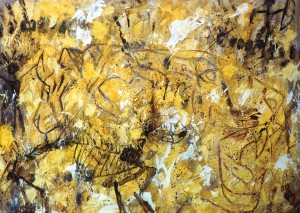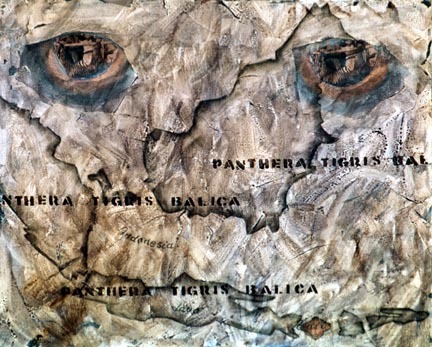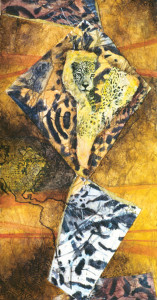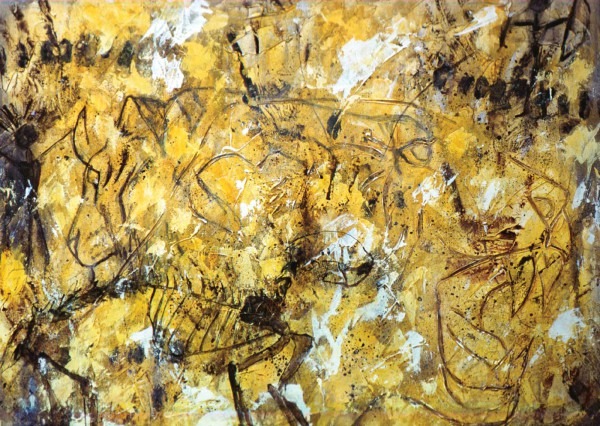Pushing people to look deeper, ask questions, and take action
It is very important to me to be a good steward of the earth. Through the monumental exhibit Environmental Impact, I am a messenger, bringing environmental awareness to many. My goal is to inspire action and good stewardship of our earth and its creatures, to motivate my viewers to accept responsibility for the deterioration of our planet, and to incite change.
As an artist I want my paintings to connect people with wildlife policies and issues, so that they look deeper, ask questions, and take action. My art visualizes what is invisible.
No one person created the state our earth is in, so no one person can fix what has been done. It is a group effort. And some things will not change. For example, no one can bring back extinct species of wildlife. But if my viewers accept the challenge, they will protect those that still exist and keep them safe. They themselves can promote and become good stewards. The protection of our planet is everyone’s responsibility. Everyone needs to do their part if we are to succeed.
There are all sorts of issues related to human abuse of the earth. I try to keep informed on the issues, especially those related to animals and endangered wildlife, which are most important to me personally and the focus of my mixed media work. Learning about these appalling situations is often tough to take. On the Asian market, did you know a dead tiger with all its parts is valued at $70,000?
I believe as an animal artist I need to learn all I can about my subjects. About 20 years ago, in doing so, I found out more than I anticipated when trying a new technique to paint a tiger I had photographed at a zoo. I learned about care in some “zoos”, about extinct species and about the IUCN Red List of Endangered Species. I remember thinking to myself, “I should have known this –others need to know about this and I have to tell them.”
This was the trigger that caused some of my art to be concerned with the environment. So in addition to painting images of the beautiful wildlife I had observed and photographed in captivity, I needed to create work that sent a message. I needed to speak for the animals that could not speak for themselves and those that were gone from the earth.
I developed a body of work focused on the plight of endangered great cats and other wildlife, and put it on exhibition alongside my other paintings and it was called The Great Cat Experience. There were 60 pieces total, and the program was designed with an educational component for children as well as adults. It reviewed general traits and characteristics of certain species, and it exposed the plight these animals are enduring.
Three of those paintings are included in Environmental Impact: Roaring Silenced, Last Killed and Losing Ground. These paintings address the animals’ current predicament across the globe including threats to their existence and extinction:
In Roaring Silenced, one of today’s tigers is disappearing out of the back of the head of a sabretooth cat, a tiger skeleton blemishes the surface and cave wall symbols signify the hunting and killing of these animals and their immortality only on cave walls.

Last Killed is a poignant piece for me. The last Bali tiger was killed in September of 1937. Sadly, it was the only photo of a Balinese tiger ever taken. When you look into the eyes in this painting you can see history and the animal we can no longer enjoy.

Finally, Losing Ground is about the jaguar, a cat that was once found on US soil, but was hunted to extinction in the late 1940s. Deforestation and fragmentation of forest habitat isolates jaguar populations; humans compete with jaguars for prey and the overhunting forces jaguars to prey on domestic animals. Jaguars are frequently shot on sight, despite protective legislation, and it fuels the vicious cycle of human-wildlife conflict.

I am a small part of the whole in stewardship of the earth. My hope is that through my art I can relay the message to protect what we have and inspire change. I know I said that already, but it is worth saying again.
Chief Dan George said it best:
“If you talk to the animals they will talk with you and you will know each other. If you do not talk to them you will not know them, and what you do not know you will fear. What one fears one destroys.”
The artworks by Carol Santora published in this post are currently on national tour in the traveling museum exhibition, Environmental Impact. Santora is an Associate Member of the Society of Animal Artists.
 Best known for her expressionistic and soulful animal paintings, Santora works in soft pastel, mixed media and acrylic, and her styles are equally diverse. Her subjects range from mustangs she works with and other domestics to Maine wildlife and the great cats. Her current work is divided between intimate equine pastel portraits and conceptual, symbolic, drip-method paintings in acrylic.
Best known for her expressionistic and soulful animal paintings, Santora works in soft pastel, mixed media and acrylic, and her styles are equally diverse. Her subjects range from mustangs she works with and other domestics to Maine wildlife and the great cats. Her current work is divided between intimate equine pastel portraits and conceptual, symbolic, drip-method paintings in acrylic.
This post is part of the MAHB’s Arts Community space –an open space for MAHB members to share, discuss, and connect with artwork processes and products pushing for change. Please visit the MAHB Arts Community to share and reflect on how art can promote critical changes in behavior and systems and contact Erika with any questions or suggestions you have regarding the new space.
MAHB-UTS Blogs are a joint venture between the University of Technology Sydney and the Millennium Alliance for Humanity and the Biosphere. Questions should be directed to joan@mahbonline.org
MAHB Blog: https://mahb.stanford.edu/blog/animals-lost-and-threatened/
The views and opinions expressed through the MAHB Website are those of the contributing authors and do not necessarily reflect an official position of the MAHB. The MAHB aims to share a range of perspectives and welcomes the discussions that they prompt.
